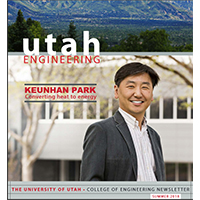A lot of energy generated from everyday devices is wasted in the form of heat.
Whether it’s a car engine, solar panels or the central processing units (CPUs) that run laptops or smartphones, these devices inevitably dissipate heat into the environment. As of 2017, more than 66 percent of energy resources consumed in the U.S. is wasted in the form of heat, said University of Utah mechanical engineering assistant professor Keunhan “Kay” Park. “If you were to recycle just a portion of waste heat into electricity, that would have a huge impact on every person’s life,” he added.
Park and his doctoral student Mohammad Ghashami may have a viable solution: Capture more of the thermal radiation emitted from a wasted heat source and convert it into electrical power using a low-bandgap photovoltaic cell. All hot surfaces release heat in the form of thermal radiation, whether it’s from the sun at 5,500 degrees Celsius or from an incandescent light bulb. Within the thermal radiation spectrum, Park believes mid-infrared light can be used to capture more energy. The question is, how much energy can be captured from thermally-radiated infrared light?
In a recently published paper in
Physical Review Letters, his team has experimentally verified that if they reduce the gap between two plates — one a hot plate that emits thermal radiation and the other a cold plate that absorbs it — they can greatly increase the amount of radiative energy transfer.
“Traditionally, we used to believe thermal radiation had nothing to do with the distance in the gap,” Park said, “But we’ve now learned that as the distance gets smaller we can boost that thermal radiation by orders of magnitude. This means we can also boost the amount of electricity generated if the cold plate is replaced by a low-bandgap photovoltaic cell.”
There are some additional obstacles, however. The gap has to be about 100 nanometers, or about several hundred times thinner than a human hair, to make this energy conversion attractive for waste heat recovery.
While researchers are still looking for more efficient methods of converting that mid-range spectrum of thermal radiation into electricity, Park believes that within 10 years, prototype devices can be invented to generate electricity from thermally-radiated waste heat. This means devices such
as a cellphone or laptop could run longer by recycling the heat from their main computer chips to recharge batteries. Park also imagines cars that could store additional electrical power by capturing the heat from the engine block.
“How can we optimize that power generation? How can we design and make a device that can be used for applications? Each of these steps could have barriers,” Park said. “But we are trying hard to make it happen.”
Park’s research is focused on the energy transport and conversion at micro/nanoscales for various applications, particularly for renewable energy. He received his bachelor’s and master’s degrees in mechanical engineering from Seoul National University in Korea and a doctorate in mechanical engineering from the Georgia Institute of Technology. He began studying the effects of thermal radiation at nanoscales because he believes there is great potential in learning more in this area, especially in energy applications.
“As an engineering professor, I really want to impact society, particularly in sustainability. That’s my big goal,” he said. “The population is growing so fast and energy consumption is growing even faster — not only in the U.S. but also in developing countries. So now the question is will we have enough energy resources to sustain all the human beings on the globe?”
Reprinted with permission from the
College of Engineering Summer 2018 Newsletter.



